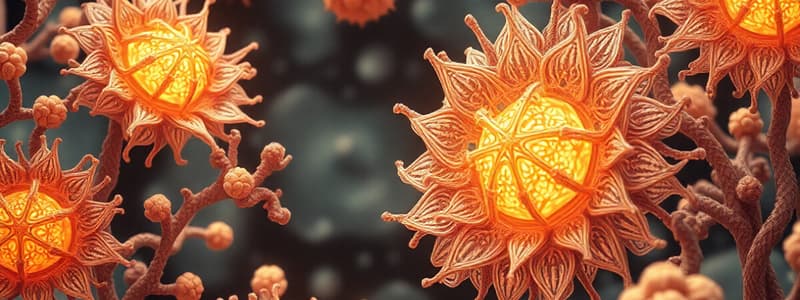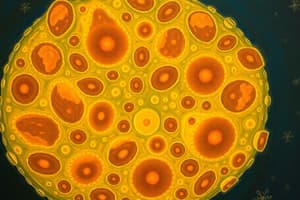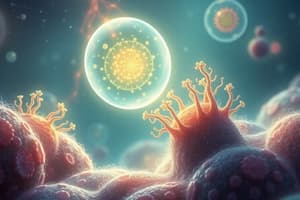Podcast
Questions and Answers
What is a characteristic of protists that distinguishes them from bacteria?
What is a characteristic of protists that distinguishes them from bacteria?
- They have a nucleus. (correct)
- They are all multicellular.
- They lack any form of movement.
- They are prokaryotic.
Which group of protozoans is known for moving using cilia?
Which group of protozoans is known for moving using cilia?
- Ciliaphorans (correct)
- Zooflagellates
- Sporozoans
- Sarcodines
Which of the following statements about sporozoans is true?
Which of the following statements about sporozoans is true?
- They are always free-living organisms.
- They move actively using flagella.
- They reproduce both sexually and asexually. (correct)
- They are autotrophs that photosynthesize.
What type of nutrition do heterotrophic protists utilize?
What type of nutrition do heterotrophic protists utilize?
Which protozoan is classified as a zooflagellate?
Which protozoan is classified as a zooflagellate?
What is the primary method of movement for sarcodines?
What is the primary method of movement for sarcodines?
Which of the following is NOT characteristic of protozoans?
Which of the following is NOT characteristic of protozoans?
What type of organism are protists classified as?
What type of organism are protists classified as?
What are the main characteristics of protists?
What are the main characteristics of protists?
Which group of protozoans is characterized by their method of movement using pseudopodia?
Which group of protozoans is characterized by their method of movement using pseudopodia?
Which protozoan group is known for its whip-like structures for locomotion?
Which protozoan group is known for its whip-like structures for locomotion?
Which of the following statements about sporozoans is correct?
Which of the following statements about sporozoans is correct?
Which of the following best describes the nutritional strategies of protists?
Which of the following best describes the nutritional strategies of protists?
What distinguishes protozoans from other types of protists?
What distinguishes protozoans from other types of protists?
In which group of protozoans are organisms such as Paramecium classified?
In which group of protozoans are organisms such as Paramecium classified?
Which of the following methods of reproduction do sporozoans utilize?
Which of the following methods of reproduction do sporozoans utilize?
Which organism is an example of a Zooflagellate?
Which organism is an example of a Zooflagellate?
What unique feature do Ciliaphorans possess?
What unique feature do Ciliaphorans possess?
What is one characteristic that distinguishes protozoans from other groups of protists?
What is one characteristic that distinguishes protozoans from other groups of protists?
Which group of protozoans is known for reproducing both sexually and asexually?
Which group of protozoans is known for reproducing both sexually and asexually?
Which organism is an example of a sarcodine?
Which organism is an example of a sarcodine?
What type of locomotion do zooflagellates primarily use?
What type of locomotion do zooflagellates primarily use?
What is a defining trait of ciliaphorans?
What is a defining trait of ciliaphorans?
Flashcards are hidden until you start studying
Study Notes
Prokaryotes and Eukaryotes
- Prokaryotic cells lack a nucleus and membrane-bound organelles.
- Eukaryotic cells have a nucleus and membrane-bound organelles.
Protists
- Mostly unicellular organisms.
- Eukaryotic.
- Not plants or animals.
- Classified into four "Supergroups."
Protist Nutrition
- Heterotrophs (animal-like): Consume other organisms for food.
- Autotrophs (plant-like): Produce their own food through photosynthesis.
- Decomposers (fungus-like): Break down dead organic matter.
Protozoans (Animal-like Protists)
- Unicellular.
- Eukaryotic.
- Heterotrophic.
- Capable of movement.
Types of Protozoans
- Sarcodines: Move using cytoplasm extensions called pseudopods. Example: Amoeba.
- Zooflagellates: Propel themselves using whip-like structures called flagella. Examples: Trichonympha (digests cellulose in termites), Trypanosoma (causes African Sleeping Sickness).
- Ciliaphorans (Ciliates): Largest group of protozoans. Covered in tiny hair-like projections called cilia. Example: Paramecium.
- Sporozoans: Non-motile, spore-forming parasitic protozoans. Reproduce sexually and asexually. Example: Plasmodium (causes malaria).
Prokaryotic and Eukaryotic Cells
- Prokaryotic cells do not have a nucleus or other membrane-bound organelles.
- Eukaryotic cells have a nucleus and membrane-bound organelles.
Protists
- Mostly unicellular organisms.
- Classified as eukaryotes.
- Not plants or animals.
- Divided into four "Supergroups".
Protist Nutrition
- Heterotrophs consume other organisms for food (animal-like).
- Autotrophs produce their own food through photosynthesis (plant-like).
- Decomposers break down dead organic matter (fungus-like).
Protozoans (Animal-like Protists)
- Unicellular.
- Eukaryotic.
- Heterotrophic.
- Move by various methods.
Types of Protozoans
Sarcodines
- Move by extending cytoplasm called pseudopods.
- Example: Amoeba.
Zooflagellates
- Move using whip-like flagella.
- Example: Trichonympha (digests cellulose in termites).
- Example: Trypanosoma (causes African Sleeping Sickness).
Ciliaphorans
- Largest group of protozoans.
- Have hair-like cilia for movement.
- Example: Paramecium.
Sporozoans
- Non-motile, spore-forming parasites.
- Reproduce sexually and asexually.
- Example: Plasmodium (causes malaria).
- Immature sporozoans (sporozoites) are transmitted through bodily fluids.
Prokaryotes vs. Eukaryotes
- Bacteria are prokaryotes, meaning they lack a nucleus and membrane-bound organelles.
- Protists are eukaryotes, indicating they have a nucleus.
Protist Characteristics
- Mostly unicellular organisms
- Classified into four "Supergroups"
- Can be:
- Heterotrophs (animal-like)
- Autotrophs (plant-like)
- Decomposers (fungus-like)
Protozoans (Animal-like Protists)
- Unicellular, eukaryotic, heterotrophic organisms
- Classified by their movement
- Sarcodines: Move using pseudopods (false feet), example: Amoeba
- Zooflagellates: Propel themselves with flagella, examples:
- Trichonympha (digests cellulose in termites)
- Trypanosoma (causes African Sleeping Sickness, transmitted by tsetse flies)
- Ciliates: Largest group of protozoans, covered in cilia, example: Paramecium
- Sporozoans: Non-motile, parasitic, spore-forming protozoans, reproduce sexually and asexually, example: Plasmodium (causes malaria)
Trypanosoma
- Long, thin, pointed at both ends
- Possesses a nucleus and flagellum
Paramecium
- Has cilia along its edges and sides
- May have a number of internal components (labelled 1 through 12)
Plasmodium
- Transmitted through fluids from one host to another
- Immature forms are called sporozoites
Studying That Suits You
Use AI to generate personalized quizzes and flashcards to suit your learning preferences.




